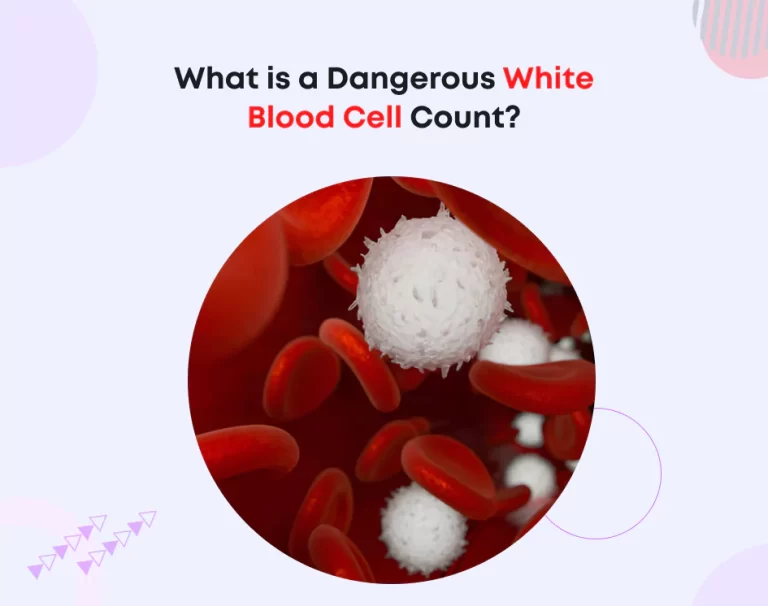
What is a Dangerous White Blood Cell Count?
White blood cells (WBCs), or leukocytes, are an essential part of our body’s immune system. These cells defend us from infections, viruses, and foreign invaders. They are produced in the bone marrow and circulate through our bloodstream. They are ready to spring into action whenever the body faces a threat. However, when the white blood cell count is too high or too low, it can signal underlying health problems.
A “dangerous” white blood cell count refers to levels that fall outside the normal range. An abnormal WBC count, whether elevated or decreased, can indicate a variety of medical conditions. Let’s see what a dangerous WBC count is and how it affects your health.
Normal White Blood Cell Count
The normal range for white blood cell (WBC) counts can vary slightly depending on the individual and the laboratory that conducts the test.
For Adults:
- Typical range: 4,000 to 11,000 cells per microliter (cells/µL) of blood.
This range can vary slightly depending on individual health conditions. Certain conditions, such as pregnancy or certain medications, may slightly alter the expected count.
For Children:
White blood cell counts in children tend to be higher than in adults, particularly in infants and young children, as their immune systems are still developing.
- Newborns (0-1 month): 9,000 to 30,000 cells/µL
- Infants (1-12 months): 6,000 to 17,500 cells/µL
- Children (1-5 years): 6,000 to 17,000 cells/µL
- Children (6-10 years): 5,000 to 15,500 cells/µL
- Adolescents (11-17 years): 4,500 to 13,000 cells/µL
Why the Difference?
Children, especially newborns, tend to have a higher white blood cell count as their immune systems are still maturing and are more reactive to infections and other immune challenges. Over time, as the body matures, the white blood cell count in children gradually decreases and approaches the adult range by adolescence.
What happens if the count goes beyond these ranges?
Whether for adults or children, a WBC count that falls outside these ranges can be due to infections, autoimmune diseases, or bone marrow problems.
If the WBC count is above or below the normal range, consult with your doctor immediately or call us.
- A WBC count above the normal range (leukocytosis) could indicate infection, inflammation, stress, or, in more severe cases, blood cancers like leukemia.
- A WBC count below the normal range (leukopenia) could suggest bone marrow problems, viral infections, certain medications, or immune system disorders.
Symptoms of Abnormal WBC Cell Count
A person with an abnormal WBC count may not always show noticeable symptoms, but signs of infection or illness are common when WBC levels drastically change.
Symptoms of leukocytosis (high WBC count) might include:
- Fever
- Fatigue or weakness
- Unexplained weight loss
- Swelling or redness in the affected area
- Pain or discomfort in the body
On the other hand, symptoms of leukopenia (low WBC count) may include:
- Frequent infections
- Fever or chills
- Sore throat or mouth ulcers
- Unexplained fatigue or weakness
- Shortness of breath
High White Blood Cell Count (Leukocytosis)
Leukocytosis, or an elevated WBC count, is often a sign of an infection, inflammation, or a more serious medical condition. If your WBC count is excessively high, it might indicate one of the following:
1. Infections
The body typically produces more white blood cells in response to infections. Common bacterial infections, such as pneumonia, urinary tract infections (UTIs), or meningitis, can cause a spike in WBCs. Similarly, viral infections like the flu or COVID-19 may also result in higher white blood cell counts.
2. Inflammatory Conditions
Chronic inflammation caused by conditions like rheumatoid arthritis, lupus, or inflammatory bowel disease (IBD) can elevate the WBC count. In these cases, the immune system is overactive, leading to persistent inflammation.
3. Leukemia and Other Blood Disorders
In some cases, an elevated white blood cell count could signal blood cancers like leukemia, myeloproliferative disorders, or other hematologic disorders.
Leukemia, a type of cancer that affects the blood and bone marrow, can cause WBCs to proliferate abnormally, leading to dangerously high counts.
4. Stress or Trauma
Physical trauma, surgery, or even emotional stress can trigger the body to release more white blood cells. This is a normal response, but the increase may be temporary and should subside once the stressor is resolved.
5. Allergic Reactions
Severe allergic reactions can also lead to an increased WBC count, particularly eosinophils, which are a type of white blood cell involved in the body’s response to allergens.
Low White Blood Cell Count (Leukopenia)
On the flip side, a low white blood cell count, or leukopenia, can also be dangerous. When your WBC count is too low, your body becomes more vulnerable to infections, as it may not have enough immune cells to fight off bacteria, viruses, or other pathogens. Causes of leukopenia include:
1. Bone Marrow Disorders
Conditions such as aplastic anemia, myelodysplastic syndromes, or leukemia can impair the bone marrow’s ability to produce white blood cells, leading to leukopenia. These disorders can be serious, as the body may lack enough healthy WBCs to fight infections.
2. Autoimmune Diseases
Certain autoimmune diseases, including lupus and rheumatoid arthritis, can cause the immune system to attack the body’s WBCs, leading to a low count. This can result in a weakened immune defense, making individuals more susceptible to illness.
3. Viral Infections
Certain viral infections, such as HIV/AIDS or hepatitis, can cause a decrease in white blood cell count. These infections directly affect the bone marrow and the immune system, reducing the body’s ability to produce sufficient WBCs.
4. Medications and Chemotherapy
Some medications, including chemotherapy drugs, can suppress bone marrow function and lower the production of white blood cells. This is a common side effect of chemotherapy, which targets rapidly dividing cells (including white blood cells) to treat cancer.
5. Nutritional Deficiencies
Deficiencies in vital nutrients such as vitamin B12, folate, or copper can impair the production of white blood cells, leading to leukopenia. A lack of these nutrients can affect bone marrow function, further compromising the immune system.
Treatment
Treatment largely depends on the underlying cause:
Infections: Antibiotics, antivirals, or antifungals may be prescribed to treat the infection.
Autoimmune conditions: Medications like steroids or immunosuppressants may be used to reduce inflammation and control the immune response.
Leukemia or Blood Cancer: Chemotherapy, radiation therapy, or stem cell transplants are common treatments for cancers affecting the blood and bone marrow.
Bone Marrow Disorders: In severe cases, bone marrow transplants or medications that stimulate the production of white blood cells might be recommended.
Conclusion
A dangerous white blood cell count—whether too high or too low—can indicate serious health concerns that require immediate medical attention. If you’ve received abnormal blood test results or have symptoms that suggest an immune system issue, it’s essential to seek medical advice. Early diagnosis and intervention can significantly improve the outlook and help manage or treat any underlying conditions.






